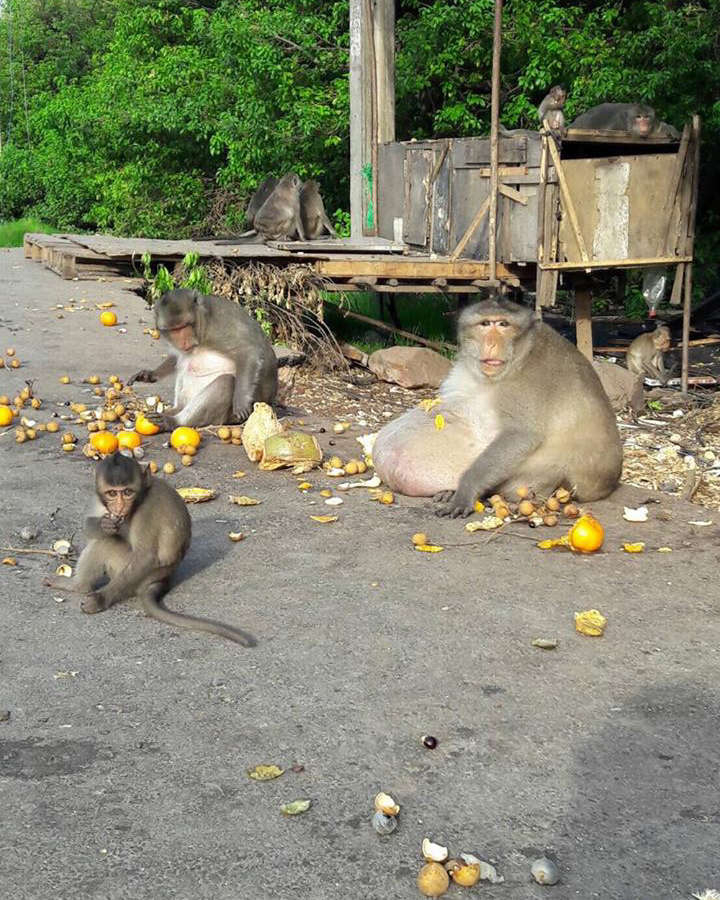In Photos: Obese Macaque Gorges on Human Junk Food
Poor monkey

This long-tailed macaque (Macaca fascicularis) has been living in the Bang Khun Thian district in Bangkok, Thailand, outside of a market, according to news reports. Nicknamed Lung Ou-an, or Uncle Fatty, the 10-year-old primate weighs a whopping 33 pounds (15 kilograms), though one researcher who saw his photos thinks he weighs even more. Typically, males of this Old World monkey species weigh between 10.4 and 18.3 pounds (4.7 and 8.3 kg), according to the National Primate Research Center at the University of Wisconsin – Madison.
Sweetcorn and milkshakes

The macaque's weight is at least partly due to the foods that tourists are feeding him, said Patricia Turner, a professor of pathobiology at the University of Guelph in Ontario, Canada. These include sweetcorn, noodles, sweet melons and even milkshakes.
The tail

The long-tailed macaque gets its name from its, you got it, tail, which is typically longer than their bodies, according to the National Primate Research Center. You can see the white coloration on this macaque's eyelids (near the nose), which is a trait of both males and females of the species.
Macho males

Male long-tailed macaques are not only taller and heftier than females, they also have larger canine teeth.
Cheek pouches

Perhaps luckily for this macaque in Bangkok, the species sports cheek pouches that let them store food while foraging (or gathering snacks from tourists) and bringing their stash back home to eat, according to the primate center.
Group living

Long-tailed macaques in the wild are generally not alone. They live in groups consisting of multiple males and females, ranging from 6 to 58 of the monkeys, according to the primate center.
Fleshy fruits

Long-tailed macaques are considered frugivorous, with a good portion of their diets consisting of fruits, according to the primate center. In Borneo, for instance, about 66 percent of their diet consists of ripe, fleshy fruits, the primate center noted.
Get the world’s most fascinating discoveries delivered straight to your inbox.
Primate obesity

Obesity is a big problem in macaques, although the affliction usually hits captive animals more than wild ones, Turner said.
Calories, calories, calories

Like humans, macaques put on pounds by consuming more calories than they burn off, Turner said. Though overall calories are key, type of food may also matter. It's easier to gain weight on sugary and fatty foods. Fatty foods pack more calories per gram than other types of macronutrients, which can contribute to weight gain, Turner said.
Recovery?

"Uncle Fatty" may need a new moniker in the near future, as officials from the Department of National Parks, Wildlife and Plant Conservation in the area brought him to a rescue center. According to a news report, the macaque, in addition to being overweight, may have lung inflammation.
Shedding pounds

To help Uncle Fatty slim down, wildlife officials have sent him to a center where he will be given a healthier diet and an exercise regime consisting of running and swinging with other animals, the Mirror reported.
Jeanna Bryner is managing editor of Scientific American. Previously she was editor in chief of Live Science and, prior to that, an editor at Scholastic's Science World magazine. Bryner has an English degree from Salisbury University, a master's degree in biogeochemistry and environmental sciences from the University of Maryland and a graduate science journalism degree from New York University. She has worked as a biologist in Florida, where she monitored wetlands and did field surveys for endangered species, including the gorgeous Florida Scrub Jay. She also received an ocean sciences journalism fellowship from the Woods Hole Oceanographic Institution. She is a firm believer that science is for everyone and that just about everything can be viewed through the lens of science.


